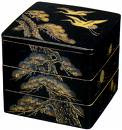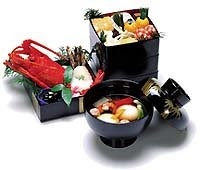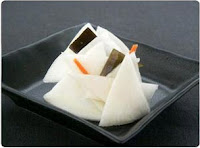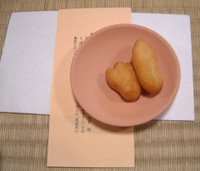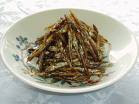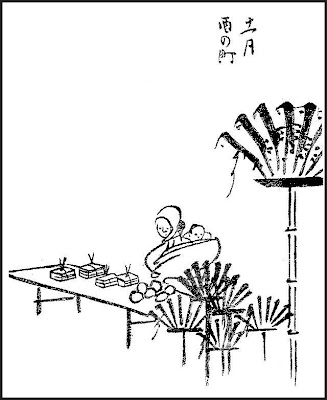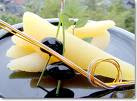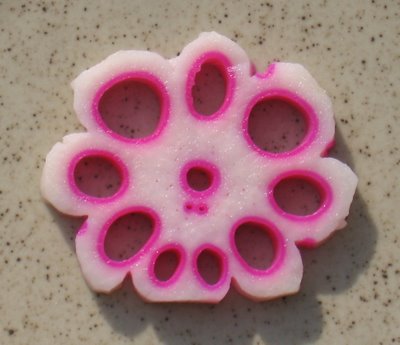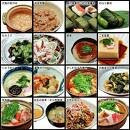::::::::::::::::::::::::::::::::::::::::::::::::::::::::::::::::::::::::::::::::::::::::::::::::::::
OKAYAMA
Momotaro Hodgepodge (momotaroo nabe)
***** Location: Japan, Okayama
***** Season: Topic
***** Category: Humanity
*****************************
Explanation
Momotaro (Momotaroo ももたろう, 桃太郎 )
the Peach Boy is the hero of Okayama city. The main street is even called "Momotaro Road", momotaroo doori 桃太郎通り and an annual festival is held in his honor.
Der Pfirsischjunge

Clay Bell from Okayama
. Momotaro 桃太郎 and Yanagita Kunio 柳田國男 .
The Folktale Discussion
MOMOTARŌ NO TANJŌ (THE BIRTH OF PEACH BOY, 1933)
:::::::::::::::::::::::::::::::::::::::::::::::::::::::::::::::::::::::::::::::::::::::::::::::::::
The city of Okayama has now "invented" a hodgepodge named after this famous hero 桃太郎鍋.
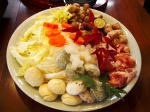 It started off with a big pot serving visitors of a festival in 2006.
It started off with a big pot serving visitors of a festival in 2006.The hodgepodge includes ass the heroes of the story. Momotaro himself is represented by kibi dango, kibidango 黍団子 millet dumplings. The red demon is represented by mochi with red rice, whereas the green demon has yomogi mugwort mochi. The local momotaro jidori 桃太郎地鶏 chicken is used for the soup. Only local vegetables are used. They are cut into the heroes of the story, carrots are cut in little monkey shapes, the white dog is formed from radish. Yellow nira leek of Okayama is also added in great quantity to represent the tail of the pheasant.
It is quite fun to pick them all out of the pot when done. So the family has something to talk about when eating together.
:::::::::::::::::::::::::::::::::::::::::::::::::::::::::::::::::::::::::::::::::::::::::::::::::::
The main story of
Momotaro and Momotaro Dolls and Amulets
. Momotaroo 桃太郎 Momotaro the Peach Boy .
:::::::::::::::::::::::::::::::::::::::::::::::::::::::::::::::::::::::::::::::::::::::::::::::::::
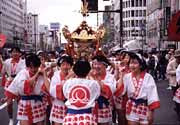
Momotaro Festival in Okayama
"桃太郎祭り" Momotaro Matsuri
source : www.pref.okayama.jp
. . . CLICK here for Photos !
One of the attraction is the dance "uraja うらじゃ", where people paint the faces in all colors and wear fancyful costumes. Groups of many villages take part and often there is a competition for the best costumes and dancing.
My own village Ohaga also has a dance groupe of this kind.
. . . CLICK here for URAJA Photos !
桃太郎祭りずし弁当 Sushi for the Momotaro Festival
. . . CLICK here for Photos !

. Shrine Kibitsu Jinja 吉備津神社 .
:::::::::::::::::::::::::::::::::::::::::::::::::::::::::::::::::::::::::::::::::::::::::::::::::::
The story of Momotaro may be related to the old believes of the onmyodo 陰陽道 Yin-Yang Worldview. The direction of bad influence, kimon, is in the ushi-tora (bull tiger) direction. So one of the demons Momotaro is fighting has horns and the other wears a tiger skin.
And the Monkey, Dog and Pheasant are animals in the zodiac, in the opposite heavenly direction from the kimon 鬼門 .
The peach itself is seen as an auspicious symbol.
In the shrine Abe Jinja 安部神社 at the kimon related to the imperial palace in Kyoto is a metal peach, where people come to touch it to ward off evil 厄除けの桃 even today.
. . . CLICK here for Photos !
:::::::::::::::::::::::::::::::::::::::::::::::::::::::::::::::::::::::::::::::::::::::::::::::::::
Momotarō (桃太郎)
 is a popular hero from Japanese folklore. His name literally means Peach Tarō; as Tarō is a common Japanese boy's name, it is often translated as Peach Boy. Momotarō is also the title of various books, films, and other works that portray the tale of this hero.
is a popular hero from Japanese folklore. His name literally means Peach Tarō; as Tarō is a common Japanese boy's name, it is often translated as Peach Boy. Momotarō is also the title of various books, films, and other works that portray the tale of this hero.The popular Children's song about Momotarō titled Momotarō-san no Uta (Momotarō's Song) was first published in 1911. One version of it is included below with romanization and translation.
Momotarō-san no uta (Momotarō's Song)
桃太郎さんの歌
Momotarō-san, momotarō-san (Momotarō, Momotarō)
桃太郎さん、桃太郎さん
Okoshi ni tsuketa kibidango (Those millet dumplings on your waist)
お腰につけたきびだんご
Hitotsu watashi ni kudasai na? (Won't you give me one?)
一つ私に下さいな!
Agemashou, agemashou (I'll give you one, I'll give you one)
あげましょう、あげましょう
Ima kara oni no seibatsu ni (From now, on a quest to conquer the ogres)
今から鬼の征伐に
Tsuite kuru nara agemashou (If you come with me, I'll give one to you)
ついてくるならあげましょう
© More in the WIKIPEDIA !
4月に行われていた岡山桃太郎まつり
おかやま桃太郎まつり - Wikipedia -
:::::::::::::::::::::::::::::::::::::::::::::::::::::::::::::::::::::::::::::::::::::::::::::::::::::

Momotaroo tomato 桃太郎トマト
Momotaroo tomato serii 桃太郎トマトセリー
Jelly from Momotaro Tomatoes
Momotaroo goorudo 桃太郎ゴールド Momotaro Gold Tomatoes
The skin is rather thin.
. . . CLICK here for Photos !
These tomatoes are a special kind of "sugar tomatoes シュガートマト" with a high sugar content.

Momotaro tomato amanatto トマト甘納豆
Sweet tomatos with a sugar coating
Momotaro grapes 桃太郎ぶどう momotaroo budoo
are big and green and very sweet. They have no kernels and the skin can be eaten too.
. . . CLICK here for Photos !
:::::::::::::::::::::::::::::::::::::::::::::::::::::::::::::::::::::::::::::::::::::::::::::::::::::
Momotaro and Daruma ... 桃太郎とだるま

23x35cm
Painted with the wish to recover from illness.
source : www.eisai.co.jp/museum
One of the "smallpox paintings" . hoosoo-e 疱瘡絵 .
:::::::::::::::::::::::::::::::::::::::::::::::::::::::::::::::::::::::::::::::::::::::::::::::::::::
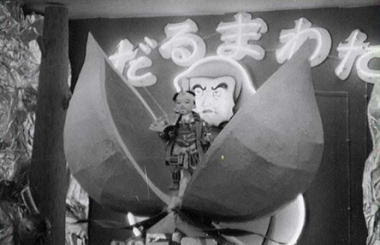
Showa 33 in Shimonoseki
source : www.darmax.co.jp
:::::::::::::::::::::::::::::::::::::::::::::::::::::::::::::::::::::::::::::::::::::::::::::::::::::
Chawanmushi served in a Daruma bowl
together with a Momotaro Sushi

桃太郎寿司でだるまの ハンニバル茶碗蒸し
source : blog.nan-can.com
:::::::::::::::::::::::::::::::::::::::::::::::::::::::::::::::::::::::::::::::::::::::::::::::::::::
Bichu, Kurashiki Anko Meguri Stamp Ralley, October 2009
備中・倉敷あんこめぐり スタンプラリー
WASHOKU -Sweets from Okayama
Kurashiki Tenryo Sushi Matsuri / Okayama no Matsuri Sushi
and other festivals in Kurashiki
Bii Kyuu Gurume B級グルメ Grade B Gourmet, Okayama prefecture
Grade B Gourmet Meeting in Tsuyama
おかやまB級グルメフェスタin津山
B Kyu Gurume .. Festa in Tsuyama
March 20 / 21, 2010 in Tsuyama town
:::::::::::::::::::::::::::::::::::::::::::::::::::::::::::::::::::::::::::::::::::::::::::::::::::::
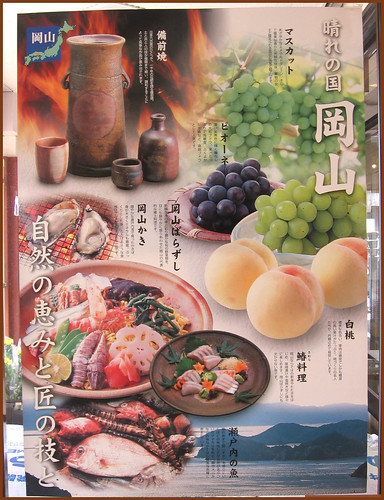
Other dishes from Okayama
amidaikon あみだいこん
amiebi (ami-ebi) shrimp, radish and ginger are cooked with soy sauce, rice wine and sugar. A dish to bring autumn to the region of the Inland sea.
. . . CLICK here for Photos of ami-ebi あみえび!
aounagi, ao-unagi アオウナギ, アオ鰻 blue eel from Bizen Kojima Bay
arasuka アラスカ, arasuka mame アラスカ豆 Alaska green peas
arasuka gohan アラスカご飯 cooked rice with green peas.
barazushi ばらずし バラ寿司)Gemischtes Sushi
In Okayama wird ein reichbestücktes Sushi in einem Teller angerichtet. Auf den Sushi-Reis kommen verschiedene Auflagen, es ist eine Art, die auch „chirashizushi“ genannt wird. Der Segen des Meeres und der Segen der Berge leuchtet in bunten Farben auf dem weißen Reis. Der Regionalfürst von Bizen und Okayama, Ikeda Mitsumasa (1609-1682), erließ damals einen Sparbefehl, nach dem für eine Mahlzeit nur „eine Suppe und ein weitere Speise“ serviert werden durften. Seine schlauen Untertanen umgingen diesen Befehl, indem sie auf einem großen Teller Reis allerlei Fischstücke, Garnelen und andere Meeresfrüchte sowie viele Gemüsesorten der jeweiligen Saison anhäuften. Dieses farbenprächtige Sushi hat sich bis heute erhalten und darf bei keiner Feier oder Festlichkeit fehlen, es wird daher auch „Festtags-Sushi“ (matsurizushi) genannt.
bengara karee ベンガラカレー Bengara Curry from Fukiya Village
dodomese どどめせ sushi rice with mixed ingredients
a kind of takikomi gohan with vinegar, to make a sushi. The beginning of the chirashizushi of Okayama. Already prepared in the Kamakura period. At that time, there was a stop-over for ships from Bizen to Fukuoka, where the takasebune ships used this kind of mixed rice as obento. The original word was doburoku meshi どぶろくめし (doburoku is cloudy white sake rice wine). It is also the origin of Bizen barazushi 備前ばらずし.
. . . CLICK here for Photos !
::::::::::::::::::::::::::::::::::::::::::::::::::::::::::::::::::::::::::::::::::::::::::::::::::::

FAGI FOODS ファジフーズ
Fagiano Okayama ファジアーノ岡山
icecream from Hiruzen milk
onigiri with mentaiko
Fagi Chicken KATSU Burger ファジチキン勝バーガー
Fagi crepe
Chahan bento チャーハン弁当 fried rice bento
pon juice ポンジュース orange juice
. . . CLICK here for Photos !
Fagiano Okayama Football Club is a football club from Okayama, Okayama, Japan. Fagiano currently play in the J. League Division 2, the second-tier professional football league in the country. Fagiano in Italian means "pheasant", and it's a reference to the pheasant that was a companion of local legend character Momotarō. Their mascot Fagi-kun is based on the specific species native to Japan, the Green Pheasant.
© More in the WIKIPEDIA !
::::::::::::::::::::::::::::::::::::::::::::::::::::::::::::::::::::::::::::::::::::::::::::::::::::
funameshi フナ飯 rice with funa fish
gonboo baagaa ゴンボーバーガー,牛蒡バーガー, ごんぼうバーガー” hamburger with gobo
Ibara town 井原
The town grows a lot of the variety Meiji goboo (gonbo in the local dialect) and puts this vegetable in many dishes. It is also sold as a "station lunch" ekiben.
明治ごんぼうバーガー
CLICK here for PHOTOS !
hime toogarashi 姫とうがらし roter Pfeffer aus Okutsu
hime togarashi, red hot chili peppers
. . . CLICK here for Photos !
It is sold in various preparations, dried, as powder or in hot oil salad dressing. Even Konnyaku is flavored with red chili (konnyaku hime).
.................................................................................
Hiruzen Yakisoba 蒜山焼そば fried noodles from Hiruzen
Flavored with miso sauce.
This has become more popular with the B-Kyu Gurmet movement, and even one prizes.
It is an old dish, keeping the tradition of the region. In winter, when snow covered the exit passes fro the highlands, farmers had to make do whith what they could preserve. So each family used some kind of miso pickles and a home-made miso-sauce mix for a "family flavor".
The chicken for this dish come from old hens, which have done their duty laying eggs. It was suggested to use young chicken with softer meat, but that is not the tradition of Hiruzen farmers, so the old ways were revived in this popular noodle dish.
. . . CLICK here for Photos !
Hiruzen okowa 蒜山(ひるぜん)おこわ Mochi-Klebreis mit roten Bohnen
und anderem Gemuese aus dem Hiruzen Hochland
. . . CLICK here for Photos !
:::::::::::::::::::::::::::::::::::::::::::::::::::::::::::::::::::::::::::::::::::::::::::::::::::::

horumon udon ホルモンうどん udon noodles with innards
hormon udon
In the town of Tsuyama 津山市 this is quite popular as one of the B-kyu B 級グルメ second class gourmet foods. It even won third grading in the All Japan B-Kyu events in 2009. It was served at our village sports festival this autumn, look at the delicious photo above!
. . . CLICK here for Photos !
ホルモンのうどん振舞う運動会
they even serve
hormon udon noodles -
villge sports festival
Gabi Greve, October 2009
:::::::::::::::::::::::::::::::::::::::::::::::::::::::::::::::::::::::::::::::::::::::::::::::::::::
inoshishi raamen いのししラーメン with wild boar meat
from Niimi town, Okayama 新見市岡山県
kakioko, kaki oko カキオコ omelette with oysters
kaki okonomiyaki ... kakioko was coined in 2008 for promoting the village.
About 10 to 15 oysters per portion are put in a kind of okonomiyaki pizza style omelette with a lot of cut cabbage.
It is also called "Hinase yaki" 日生焼き
from Hinase fishing port 日生地区, near Bizen
. . . CLICK here for Photos !
kako no jabujabu 水夫のじゃぶじゃぶ sailor's jabu-jabu
Ushimado 牛窓

karee, furuutsu karee フルーツカレー curry with local fruit
like peaches, persimmons, pione grapes, Momotaro tomatoes and even innards of pork (horumon karee)
Click on the photo to start your walk through our local specialities.
Kasaoka raamen 笠岡ラーメン Kasaoka ramen noodle soup
made only with chicken meat (chikin chaashuu) and chicken soup, since more than 50 years.
After the war, Kasaoka town was surrounded by chicken farms.
CLICK here for PHOTOS !
kenbiki-yaki, kenbikiyaki ケンビキ焼き, けんびき焼き
Kenbiki, kembiki in local dialect means "to be tired".
In the local dialect, the first of June, rokugatsu ichinichi, rokugatsu hitohi was pronounced rokkahidee ロッカッヒテエー was one whole day in June when the farmers did the planting of rice seedlings. All villagers would stop their other work and be out in the fields, also called shiromidi シロミテ, white day.
On this day, the kenyiki-yaki, prepared in a hooroku ホウロク earthen pan wrapped in leaves of myoga ginger was offered to the local deities (ujigami 氏神様、内神様) and later eaten by the whole family.
. . . CLICK here for Photos !
Recipe see below.
kibimochi, kibi mochi きび餅 mochi with millet
Often mochikibi もちきび flour is used to make it.
They were a substitute for poor farmers who could not afford to use mochigome rice in olden times.
. . . CLICK here for Photos !
Kokerazushi こけら寿司 / 柿寿司 / こけら鮨 layered sushi
from Hiruzen. kokera sushi
kurobuta from Nagi, Sakushuu 作州 black pork meat
Sakushuu kurobuta sushi with sushirice and black beans
yellow nira from Nagi
kusagina kakemeshi くさぎなかけめし
rice with kusagina leaves
From Kibi Chuo Town, Kibi Kogen highlands 吉備高原
kusagina are the leaves from a tree of the verbena officinalis family (kumatsuzura クマツヅラ科), which grows about 3 meters in hight. The leaves are big and eggshaped and have a strong smell. The leaves are dried and eaten as hozonshoku by the hunters of the mountainous area. They are rich in vitamin C and Calcium.
It is now also prepared as a school lunch and sold in packs online.
. . . CLICK here for Photos !
:::::::::::::::::::::::::::::::::::::::::::::::::::::::::::::::::::::::::::::::::::::::::::::::::::::
mamakari, sappa ままかり(さっぱ) Sardinella zunasi
. . . . . mamakarizushi ままかりずし sushi with mamakari fish
mogai 藻貝 / もがい も貝 small clams
Boiled as tsukudani, put on the bento lunchbox or in miso soup.
mokuzugani 藻屑蟹 / モクズガニ Japanese mitten crab
from Kumenan, along the river Asahigawa 久米南, 旭川
:::::::::::::::::::::::::::::::::::::::::::::::::::::::::::::::::::::::::::::::::::::::::::::::::::::
otsukakegohan, o-tsu kakegohan お汁かけごはん
rice with miso sauce
A bowl of local rice is doused with a bowl of miso sauce. A few pickled vegetables as a side dish make a simple farmer's meal.
Kumen Town, Michi no Eki 道の駅久米の里
source : Sanyo Shinbun, December 2009
:::::::::::::::::::::::::::::::::::::::::::::::::::::::::::::::::::::::::::::::::::::::::::::::::::::
- new instant ramen soups インスタント ラーメン
gomamiso raamen ごまみそラーメン with sesame seeds and miso paste
momotaroo dango raamen 桃太郎団子ラーメン with chicken meatballs
satoyama raamen 岡山里山ラーメン "Village noodle soup" with mushrooms and all kinds of vegetables
setouchi kaki raamen 瀬戸内カキラーメン from Setuichi, with oysters
:::::::::::::::::::::::::::::::::::::::::::::::::::::::::::::::::::::::::::::::::::::::::::::::::::::
sabazushi サバずし / 鯖ずし
Speciality in Northern Okayama prefecture, especially prepared for the autumn festival. The salted fish was brought from Tottori during the Edo period and the farmers could only afford to buy it just after the harvest.
In my village, the farmers wifes offer their handmade sabazushi to friends and family.
. . . CLICK here for Photos !
Sakushuu kuro 作州黒 Black beans from Sakushu province
Sakushu is an old name of some northern parts of Okayama prefecture
. . . CLICK here for Photos !
sawara no kookozushi サワラのこうこずし
shirasagi komugi しらさぎ小麦 "white heron" type of wheat
good for making udon noodles.
CLICK here for PHOTOS !
tai no hamayaki 鯛の浜焼き
sakuradai no hamayaki 櫻鯛の浜焼き
from Kasaoka Town
. . . CLICK here for Photos !
. WASHOKU
Tamagokake gohan TKG 卵かけご飯 boiled rice with raw egg
Misaki Cho, 美咲町. made from tanada mai, rice from the terraced rice fields of Ohaga Nishi 大垪和西.
Ohaga, home of Gabi Greve
. Tsuchinoko ツチノコ or 槌の子 hammerspawn
legendary reptile souvenir food, Akaiwa and Yoshii
Tsuyama, B Kyu Gurume .. Festa おかやまB級グルメフェスタin 津山
March 20/21, 2010
Urajima renkon 連島レンコン lotus roots from Urajima town
連島町(つらじまちょう). Kurashiki 倉敷市
They are quite delicious when eaten raw. Harvested from late autumn onward.
. . . CLICK here for Photos !
They are also trying to make shochu (renkon shooshuu レンコン焼酎) liquor with this roots.
.................................................................................
. Oishii o-hanashi Okayama
おいしいおはなし 岡山 .
Literature and Food Event from February to March 2012
.................................................................................
- source : kyoudo-ryouri.com/en.. okayama .. -
Bukkake Udon
Hawasabi Sushi
Iidako boiled with soy sauce
Jaku Tempura
Manzen Kabura
Shino Udon
Takomeshi
Ujo Golden Sushi
*****************************
Worldwide use
*****************************
Things found on the way
Kintaro, the Golden Boy
Daruma Museum
*****************************
HAIKU
kibi, millet and
millet dumplings 黍団子(きびだんご) kibi dango
kigo for mid-autumn
ume saku ya inu ni matagaru momotarô
plum blossoms --
riding a dog
the Peach Boy
老が世に桃太郎も出よ捨瓢
oi ga yo ni momotaroo mo deyo sute fukube
to an old man's world
Peach Boy, come out!
hollow gourd
Kobayashi Issa
In Issa's journal this is the first haiku of Eighth Month, 1816. Earlier that year, the last haiku of Second Month began with the same first two phrases, but ended with "peach blossoms" (momo no hana). Though the kanji for "gourd" is today read as hisago, Issa read it as fukube. Shinji Ogawa notes that a hollowed fukube could be used as a container or bottle.
In this haiku, "the gourd becomes a magic lamp or a bottle where a Genie comes out, in this case, Peach Boy." He adds, "There is a Japanese phrase, hyootan kara koma which means 'a horse from a gourd' or 'an unexpected thing happened'."
Tr. David Lanoue
:::::::::::::::::::::::::::::::::::::::::::::::::::::::::::::::::::::::::::::::::::::::::::::::::::::
Kurashiki 倉敷 is famous for its canals and willow trees. There is a group of elders who go around town with masks and large fans and tap people on the head for good luck.
They walk around as representatives for their friends who are bedridden and can not go out.

suinkyo, su-inkyo 素隠居 (すいんきょ)persons in retirement
. . . CLICK here for Photos !
. Suinkyo Matsuri - Festival at Achi Shrine 阿智神社 .
. Toys and Talismans from Japan .
*****************************
Related words
Momotaro Food / my photos
***** WASHOKU : Local chicken (jidori)
Shoodoshima 小豆島 Shodoshima
Kagawa prefecture, but close to Okayama
***** WASHOKU : Regional Japanese Dishes
***** . Momotaroo 桃太郎 Momotaro the Peach Boy Dolls .
:::::::::::::::::::::::::::::::::::::::::::::::::::::::::::::::::::::::::::::::::::::::::::::::::::::::::::::::::::::::::::
[ . BACK to DARUMA MUSEUM TOP . ]
[ . BACK to WORLDKIGO . TOP . ]
- #okayama #momotaro -
:::::::::::::::::::::::::::::::::::::::::::::::::::::::::::::::::::::::::::::::::::::::::::::::::::::::::::::::::::::::::::
